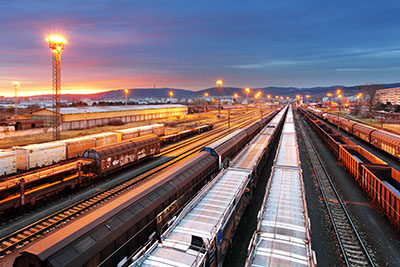AAR estimates Class I railroads will spend around $22 billion on U.S. capex and maintenance in 2017

While heading down in recent years, the capital expenditures outlay made by United States freight railroads, specifically Class Is, still remains very impressive. That was made clear in data issued by the Association of American Railroads (AAR) this week, which put the estimated tally for U.S. railroads investment on maintaining and upgrading “the nation’s private rail network” at $22 billion.
While heading down in recent years, the capital expenditures outlay made by United States freight railroads, specifically Class Is, still remains very impressive. That was made clear in data issued by the Association of American Railroads (AAR) this week, which put the estimated tally for U.S. railroads investment on maintaining and upgrading “the nation’s private rail network” at $22 billion.
AAR told LM that this estimate is based on numbers provided by Class I railroads on their fourth quarter earnings calls, minus the non-U.S. investments made by Canadian Pacific, Canadian National, and Kansas City Southern, so that U.S.-only numbers are factored in to come up with its annual capital expenditures estimate. And the AAR also uses what it calls a “ratio past precedent chart” to calculate what the maintenance number would be into a percentage of the capital expenditure number, then combining the capital expenditures and maintenance numbers to come up with the estimate.
The 2017 number represents a continuation of declines, with the 2016 AAR estimate at $25 billion, and $29 billion in 2015, which was ahead of 2014’s $27 billion.
“This year's private network spending, a combination of capital expenditures and maintenance, is part of a continued trend of remarkable proportions, including more than $630 billion since the industry was partially deregulated,” said AAR President and CEO Edward R. Hamberger in a statement. “As the House of Representatives convenes…to discuss a '21st Century Infrastructure' and policymakers continue bipartisan discussions with the Trump administration, we hope these leaders realize how important America's private freight rail network is in moving raw and finished products, supporting the U.S. manufacturing sector, providing a foundation for commuter and passenger rail and lessening deterioration of this country's public infrastructure. We pay so taxpayers do not, an undeniable benefit to the U.S. economy. Our role in moving the country's freight is critical and we look to be a productive part of a bipartisan infrastructure debate. Unlike most other transportation modes, we do not have a hard 'ask' of policymakers other than to remain free to do what we do best: safely, affordably and efficiently move goods and earn the revenues needed to continue this massive investment.”
The AAR said its projected 2017 estimate of $22 billion in private spending, which it said covers upgraded track and locomotives and technological advancements to meet demand and make a safe network safer, equals around $60 million per day. Other supporting data points it offered up include: how freight railroads invest six times more of revenues in capex than the average U.S. manufacturer; create almost $274 million in economic activity; generate almost $33 billion in state and federal tax revenues; and supported almost 1.5 million U.S. jobs in 2014, the most recent year for which data is available.
With the AAR’s 2017 estimate of $22 billion down 12 percent from 2016’s $25 billion, it explained that is a byproduct of how “the industry continues to retool around a changing customer market and shifting traffic patterns––most notably the massive decline of coal production.”
As was the case last year, when the AAR numbers were issued, estimated 2017 Class I spend projections being down in in sync with full-year 2016 volume declines that saw U.S. carloads fall 8.2 percent annually at 13,096,860, compared to 2015’s 14,266,012, while intermodal containers and trailers volume decreased 1.6 percent annually to 13,490,491 units compared to 2015’s 13,710,662.
To be sure, even with lower annual volumes the last two years, the railroads are not in financial peril. Instead, as Class I executives and stakeholders observe, the lower investment levels point to getting expenses in line with current market conditions, along with an eye on the future, too.
What’s more, the decline in oil prices, coupled with the ongoing decline in coal loadings, has had a negative impact on Class I revenues that has been hard to overcome in some ways and subsequently made it harder for the carriers to maintain the capex programs they previously had laid out, according to an industry stakeholder speaking on background. But at the same time he said there remains a long-term need for sustained investment in infrastructure and capacity expansion, as other issues, such as highway congestion will still contribute to sector growth. Instead, he explained, the question will be how long this will last, what the options might be and at what level will the Class I’s be able to continue to invest if the current predicament persists with no relief?
“As long as railroads spend on their networks, that is the strategic network, they have,” said Tony Hatch, principal of New York-based ABH Consulting. “And they continue to spend on selected growth opportunities, it is not a bare bones spending approach. There has also been a series of major projects around the country that were finishing up in 2015 or so that have come off, like intermodal terminal projects by CSX and Norfolk Southern. You will still see selected growth spending, but it will focus less on big projects with ribbon-cutting ceremonies and focus more on things like sidings to build out intermodal networks to make them more flexible and things like that. There will also likely be more concentrated spending in the East for sure, as well as out West, but it is less defined.”












